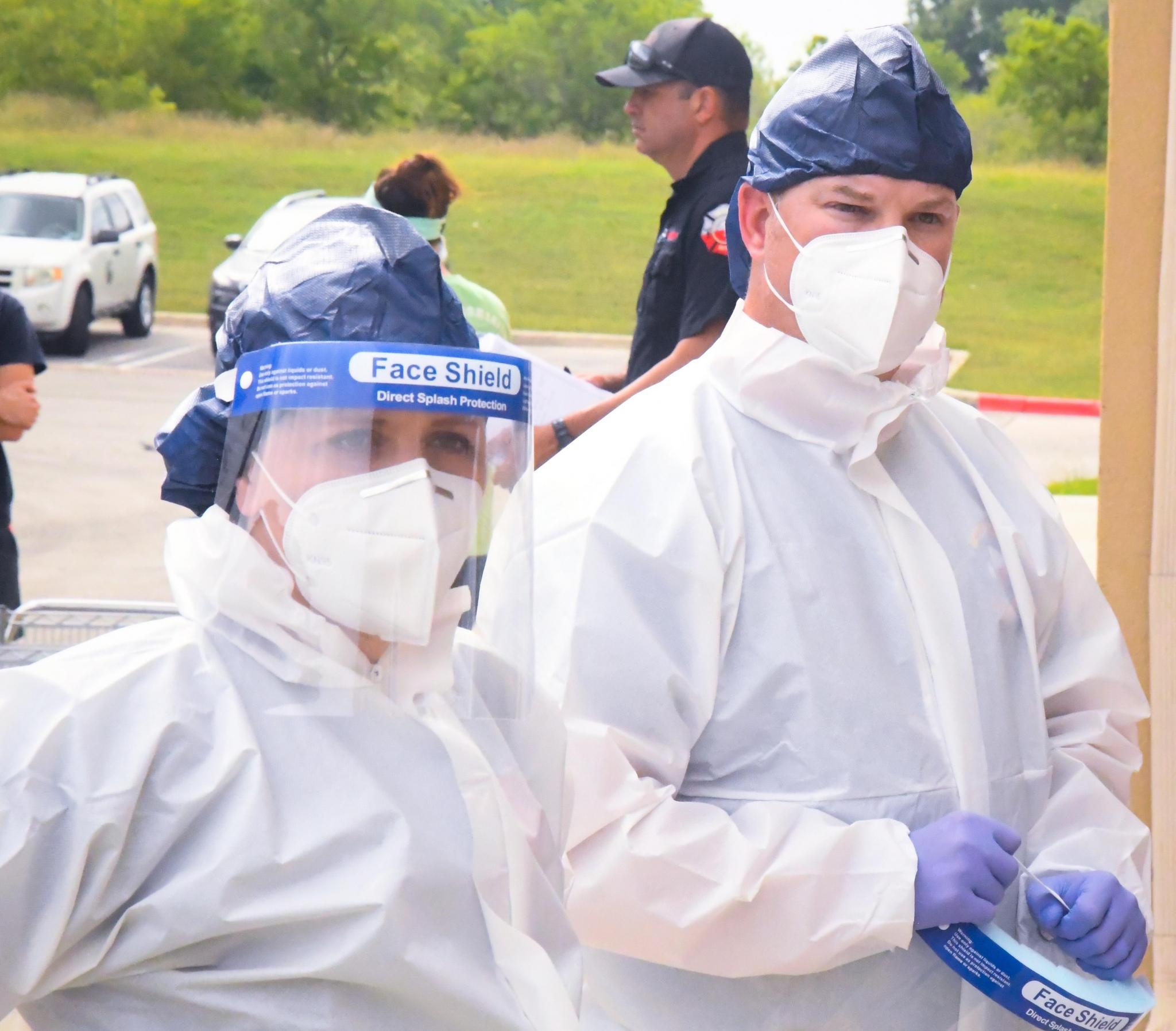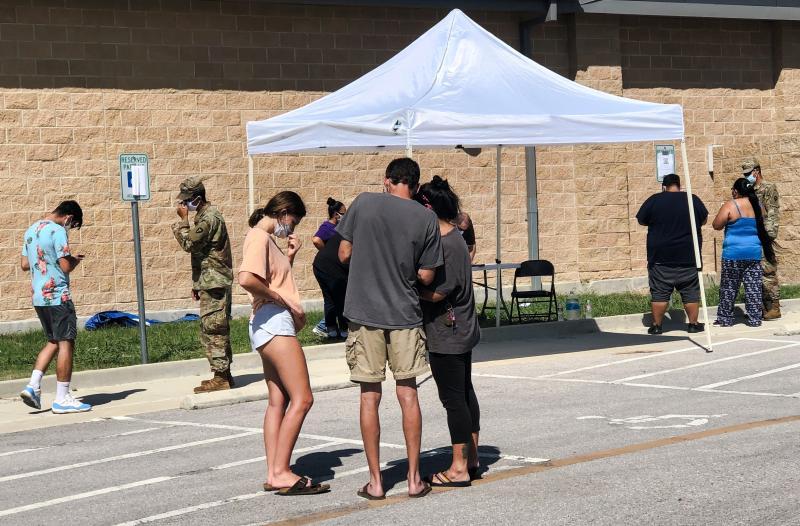
The COVID-19 pandemic impacted everyone's daily lives as it first appeared in Hays County on March 14. Above, members of a Hays County taskforce of firefighters and emergency personnel prepare to administer COVID-19 tests at a nursing home in San Marcos on May 21. Below, San Marcans visit a coronavirus testing site at San Marcos High School in July. Daily Record photos by Lance Winter.
SMDR Year in Review: The Pandemic Year
Editor's note: This story is a part of a series capturing moments in 2020.
While watching news coming out of China in late 2019, Hays County Epidemiologist Eric Schneider knew the coronavirus could become a life-altering event.
“It wasn’t going to stay contained,” Schneider said. “The virus, it was spreading so quickly, I knew it was going to reach the shores of the United States. And once it did, it was going to spread with the high-travel frequency that Americans have, I knew it was going to get to Texas quickly.”
From mask-wearing to social distancing, COVID-19 has changed the daily lives of everyone. Hays County reported its first presumptive coronavirus case on March 14. Since then, 125 county residents have died from the virus as of Tuesday, while there have been over 10,000 cases reported to the Hays County Local Health Department.
Hays County sees first presumptive positive COVID-19 case
On Jan. 21, the Associated Press reported the first case of a “mysterious Chinese illness” recorded in the U.S. In late February, Hays County, City of San Marcos and school district officials began preparing for COVID-19 to reach the county’s boundaries.
Coronavirus cancellations took hold in San Marcos on March 12. Texas State University announced that it would extend its spring break two weeks and would move to remote classes until April 12. San Marcos Consolidated ISD canceled all of its extracurricular activities — the University Interscholastic League quickly postponed all extracurricular activities. The Sun Belt Conference canceled both its men’s and women’s basketball postseason tournaments, which Texas State was scheduled to play in.
The first presumptive COVID-19 in Hays County was announced on March 14. The City of San Marcos and Hays County quickly announced a joint State of Disaster the following day.
“We knew we would eventually see cases in our area,” San Marcos Mayor Jane Hughson said at a press conference on March 14, declaring a state of disaster. “There is no reason to panic. It’s time for everyone to remain calm and to continue to practice preventive measures. We’re prepared to take the actions necessary to keep our community safe … We’re in this together and we’ll get past this together with our coordinated effort.”
Later that week, SMCISD and San Marcos Academy suspended normal operations through April 5. San Marcos announced an order closing bars and nightclubs, and prohibited gatherings of 10 or more to prevent the spread of COVID-19 on March 15.
On March 19, Gov. Greg Abbott ordered schools closed statewide until at least April 3. He also shutdown bars; restaurants, except for to-go orders; and gyms.
City of San Marcos, county aid residents amid economic hardship
Hays County and the City of San Marcos took measures to provide assistance to those affected by the pandemic. Partly in financial assistance, and partly in partnership with state level authorities to bring more testing and PPE to the area.
The city council approved an ordinance in April requiring landlords to give a 90-day notice before beginning any eviction proceedings. They also waived late fees on utilities and placed a moratorium on utility shutoffs, so long as a resident communicated their situation with the city.
The city received $425,261 CARES funding in round one and allocated the funds to its small business recovery program, advocacy for abused and neglected children and enhanced COVID-19 testing for Hays County.
The city was awarded $3.6 million in CARES Act funding and $576,825 in CDBG funding for round three.
Sticking to categorical spending requirements, staff recommended spending $289,000 on computer technology for schools, $200,000 on utility billing assistance for businesses and nonprofits and $540,000 on a phone system for the city and a learning management system. They also recommended spending $400,000 on PPE, sanitation and fencing, $200,000 on costs they have already spent on public health, $200,000 for an HVAC system for public buildings and $2.4 million for payroll expenses related to COVID-19.
They will be dedicating the $567,825 in CDBG-CV Round Three to an eviction prevention program as the federal moratorium on eviction comes to an end.
Hays County created ECAP, the Emergency Cash Assistance Program to aid businesses that were affected by the pandemic with up to $10,000.
Summer sees rise in virus spread
Cases remained low between the first diagnosis of the virus and mid-May. But following the Memorial Day, Father’s Day and Fourth of July holidays, Hays County saw a dramatic COVID-19 spike.
The local health department reported 278 total cases on May 27. But one month later the county tallied 1,551. By the end of July, there had been 4,315 total cases.
“Seeing (COVID-19) exploded around Memorial Day, Father’s Day and Fourth of July, I guess right at the beginning of May is when we knew this was going to be something that wasn’t going away anytime soon,” Schneider said.

On July 2, Abbott ordered a statewide mask mandate to slow viral spread throughout the state.
Cases began to slow down in September and October. Schools began returning to in-person learning. But cases again started rising at the beginning of November and continued to do so as the year came to a close.
Looking to 2021
With the emergence of new vaccines to combat COVID-19, the pandemic could slow down in the new year. But Schneider said to expect vaccine rollout to be slow with a return to normalcy not expected until the summer.
“I think we’re going to be seeing (COVID-19) as a part of our daily lives for a while,” Schneider said. “The vaccine is going to be out there and what we ask the public is to be patient because it’s not going to be a quick rollout where all of a sudden everybody has a shot waiting for them at a pharmacy somewhere. It’s going to take a while to be able to get it to the general public.
“But with our numbers spiking, what we’re seeing right now it’s larger spikes in what we were seeing in May, June, July time period,” Schneider added. “And we haven’t even begun to see the spike we’re anticipating from Christmas and then again from New Year’s, so I have a feeling this is going to be our daily lives for at least until the summertime, if not longer.”
As 2021 arrives, Schneider continues to stress the importance of wearing masks, washing hands, practicing social distancing and staying home to halt the spread of the coronavirus.
“The non-medical interventions are the best way to help slow this spread down and help us get back to a normal life, or so-called normal life that we used to have,” Schneider said. “With the increase in the numbers and the increase in people that are becoming hospitalized, our healthcare system is starting to get taxed. And so, we just want to make sure that everybody’s staying safe and avoiding these large gatherings over this last holiday of New Year’s.”











